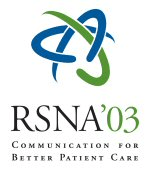
Abstract Archives of the RSNA, 2003
Franco Campostrini MD, PRESENTER: Nothing to Disclose
Abstract:
HTML
Purpose: The lymphatic drainage flowing from the scalp has been studied by means of Nuclear Medicine in order to map the head and neck lymph nodes (LyN) and determine the most appropriate therapeutic applications in patients affected with both skin cancer and aero-digestive tumors.
Methods and Materials: 33 consecutive patients ( pts.) , 28 males , 5 females , clinically negative for enlarged nodes ( by palpation and CT) , were studied by lymphoscintigraphy . They were affected with a variety of head - neck tumors , ranging from stages I - IVa AJCC. Head-Neck Lymphoscintigraphy (HNL) was performed by injecting 0.1-0.2 ml ( 14-15 MBq ) of 99mTechnetium nanocolloids at four sites of the patients scalp ( two frontal and two parietal ) . Images were obtained 3 hours afterwards, with the gammacamera in both lateral (LL) and anterior posterior (AP) projections. Then the effectiveness of HNL in showing the cephalic and cervical LyN was evaluated .
Results: A)In the LL images , the superior parotid lymph node( SPLN ) ( or preauricular node) was revealed in 100% of the cases , while the I , II , III, IV and V level LyN showed up in 4%, 93%, 54%, 14% ( 80% in AP images ) and 64% respectively. B) In 97% of the cases the SPLN was the nearest node receiving the frontal radioactive medium , whereas this seemed to happen in only 30% of the cases for the parietal injections . C) Communication between the V and the II, III, IV levels was quite frequent ( 40% of the cases ). No morbidity was observed.
Conclusion: Our research revealed that in most cases ( 97 % of pts) the superior parotid lymph node ( SPLN ) is the first node reached by the radioactive nanocolloids flowing from the anterior scalp and can be considered the sentinel one for the lesions arising on the frontal skin. In general, the incidence of lymphatic metastases is approximately 10% of the cases for skin squamous carcinomas which are poorly differentiated, recurrent, or more than 3 cm. at their largest diameter or 4 mm. in thickness. In addition, the 5 year survival rate for patients with nodal involvement is only 25%. Therefore , for pts. affected with anterior scalp tumors at risk for spreading , this protocol can be suggested : 1)At first, one or more injections around the lesions and sampling of the SPLN should be performed ( sentinel lymph node technique ), so that both the SPLN and the cervical LyN will show up . 2) In the case of SPLN involvement , surgery and /or radiotherapy should be planned on both the primary disease and the parotid nodes . The treatment of cervical LyN should also be considered.
Questions about this event email: lradioter@hotmail.com
Campostrini MD, F,
The Lymphatic Drainage of the Scalp as Studied by Lymphoscintigraphy, and Its Clinical Significance for Detecting the Sentinel Lymph Node of the Frontal Region. Radiological Society of North America 2003 Scientific Assembly and Annual Meeting, November 30 - December 5, 2003 ,Chicago IL.
http://archive.rsna.org/2003/3100136.html

